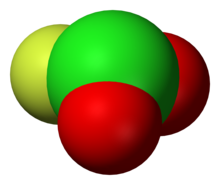 | |
 | |
| Names | |
|---|---|
| Other names chlorine dioxide fluoride | |
| Identifiers | |
3D model (JSmol) | |
| ChemSpider | |
PubChem CID | |
CompTox Dashboard (EPA) | |
| |
| |
| Properties | |
| ClFO2 | |
| Molar mass | 86.45 g·mol−1 |
| Density | 3.534 g/L |
| Melting point | −115 °C |
| Boiling point | −6 °C |
| Related compounds | |
Related compounds | Perchloryl fluoride Chloryl trifluoride |
Except where otherwise noted, data are given for materials in their standard state (at 25 °C [77 °F], 100 kPa). | |
Chloryl fluoride is the chemical compound with the formula ClO2F. It is commonly encountered as side-product in reactions of chlorine fluorides with oxygen sources. [1] It is the acyl fluoride of chloric acid.